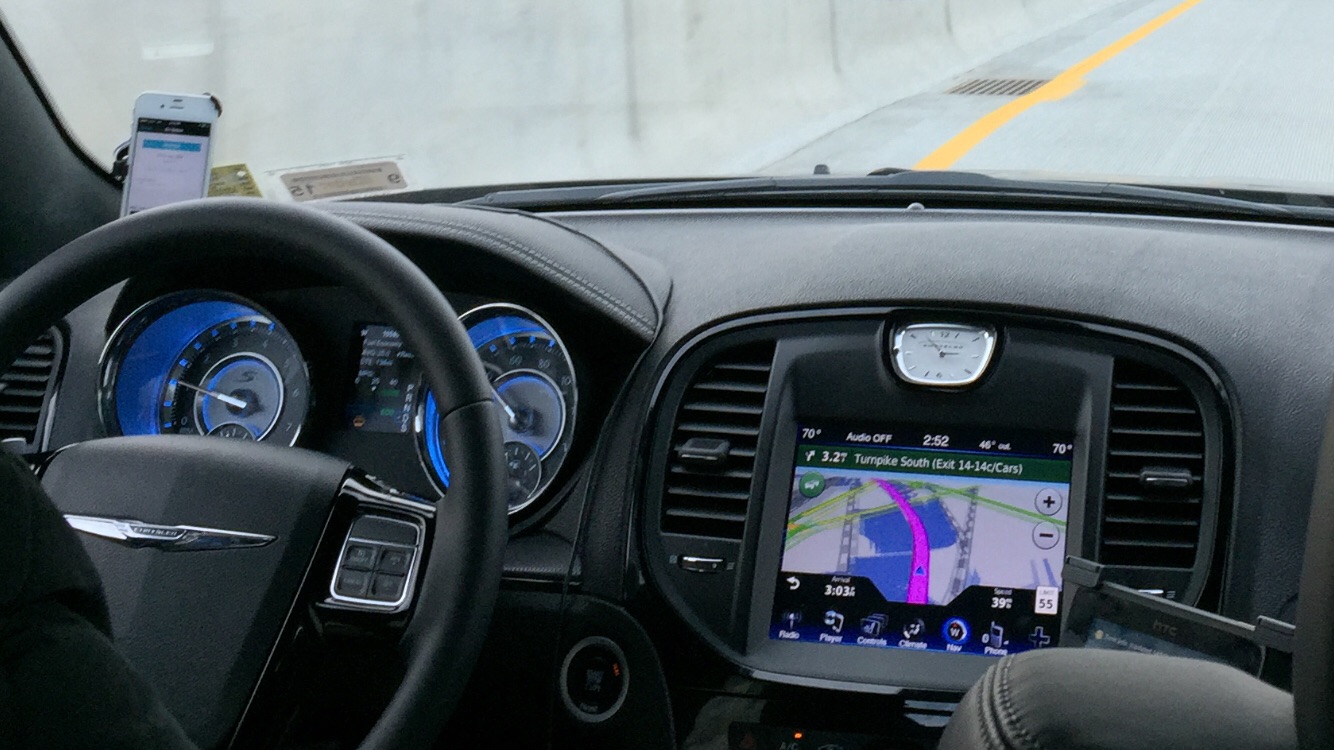Of course, Thanksgiving 2020 beckons first.
Business Models
iPhone launched in June that year. Some could tell but Nokia had no incentive (i.e. revenue models) to pivot to platforms and ecosystems. Disruptions happen because of business model asymmetries not competence asymmetries.
— Horace Dediu (@asymco) November 15, 2020
From December, 2014:

I have long used a certain car service when visiting New York. They generally offer timely and professional service at a fair price with occasional promotions.
I found it interesting that my recent driver, the son of a long time chauffeur, sported the Uber app on a new dashboard mounted iPhone 5S (see photo above).
Note the prominent placement of Uber’s iPhone app (top left). The current service offers nothing like it (they have a phone number, not great website and a terrible app that is simply a website wrapped in an app – yesterday’s news).
I asked him about this during our drive to an airport.
His response:
“Uber paid me $500.00 to try the iPhone and their app for a month.”
I asked him about their terms:
“$10/week” to participate and 20% of the ride revenue. I only do surge pricing. Their short runs for $10 to 15 are not worth it with traffic. They pay weekly, every Tuesday into my account.” “Their app works very well.”
What’s in it for Uber?
1. They are obviously targeting existing and successful drivers. They are also leaving current services in the dust from a customer and driver experience perspective.
2. Uber collects data. That prominently mounted iPhone with the Uber app knows who the driver is, his schedule and routes. It can obviously compare Uber and non Uber routes.
3. Uber has a relationship with a competitor’s driver assets. It’s rather deep and includes a financial account, active app, tracking and some customer (leads) data.
That iPhone running the Uber app is on the drivers dashboard and with him constantly.
4. This Uber relationship is an opening for other driver and client services, largely due to a superior app experience for all.
and, on the consumer side:

A friend mentioned that Uber offered free sunglasses at events when people installed the app, signed in and added a credit card.
“It pains me to say this, but in certain quarters, religious liberty is fast becoming a disfavored, right”
Supreme court justice Samuel Alito😕
Just as the COVID restrictions have highlighted the movement toward rule by experts, litigation about those restrictions, has pointed up emerging trends in the assessment of individual rights. This is especially evident with respect to religious liberty. It pains me to say this, but in certain quarters, religious liberty is fast becoming a disfavored, right. And that marks a surprising turn of events. Consider where things stood in the 1990s. And to me, at least that does not seem like the Jurassic age. When a Supreme Court decision called employment division versus Smith, cut back sharply on the protection provided by the Free Exercise Clause of the First Amendment. Congress was quick to respond. It passed the Religious Freedom Restoration Act (RFRA). To ensure broad protection for religious liberty. The law had almost universal support. In the house, the vote was unanimous. In the Senate, it was merely 97 to three, and the bill was enthusiastically signed by President Clinton today that widespread support has vanished. When states have considered or gone ahead and adopted their own versions of reference. They have been threatened with punishing economic boycotts.
Eighth, he discussed the Little Sisters of the Poor case.
Some of our cases illustrate this same trend. Take the protracted campaign against the Little Sisters of the Poor in order of Catholic nuns, the Little Sisters or women who have dedicated their lives to caring for the elderly, poor, regardless of religion. They run homes that have one high praise. Here’s some of the testimonials filed in our court by residents of their homes. The Little Sisters, quote, do everything to make us happy. I feel I’m part of the family and that’s a great feeling. They will keep you alive 10 years longer than anyplace else because they love you. Carol hassel in a nutshell, I would say this about the Little Sisters, a little bit of heaven fell from the sky one day and landed in my apartment.
Despite this inspiring work, the little sisters have been under unrelenting attack for the better part of a decade. Why because they refused to allow their health insurance plan to provide contraceptives to their employees. For that they were targeted by the prior administration. If they did not knuckle under and violate a tenet of their faith. They face crippling fines, fines that would likely have forced them to shut down their homes.
Exodus: The ironies and finalities of being on top of the world.
It’s time to build, yes. But it’s also time to leave.
The battle over tech’s supremacy has been waged and all of our premonitions came true: We wanted flying cars and got vertical take-off innovation hubs from every car maker in America. Software has not only eaten the world, but feasted on your screen-weary eyes. It has swallowed your children, your church, your bank, and your politics, and somehow it all feels inevitable. That these feats of human progress—of instant connectivity in a now homebound world—became the scapegoat of our time is another symptom of the era’s end, cueing the quiet exodus of builders who had bigger aspirations than the same-day shipping that keeps our households afloat.
Now, Silicon Valley is witnessing a reckoning, but it’s not the long-awaited one predicted by the New York press, or the antitrust bonanza that Washington longs for because too many people seem satisfied getting their news from Facebook. The reckoning is more of a realization that tech exceeded expectations and somehow squandered the fruit of its own garden, and that a city on a hill that could have supported so much innovation was not Florence in the Renaissance nor the Athenian Academy with MacBooks. Rather, it became a government-sponsored needle exchange, a haven for the homeless and forgotten that put government’s paralysis on display downtown on Market Street.
2020 is not the great reckoning predicted in the book of Revelation, despite the fires, the plagues, and the wailing on Twitter. It is the resignation and determination of Exodus, of a dogged people packing up U-Hauls and fleeing this frontier state to seek an even newer, more eternal world.
San Francisco had four times as many deaths from overdose this year as it did from the COVID-19 virus.
Above Madison: Saturday
Marketers are Addicted to Bad Data
Modern marketing is all about data and however hard you might try, you can’t spend any time around marketers online without being subjected to endless thinkpieces, how-to guides, ebooks or other dreck about how we need to track and measure and count every little thing.
We’ve got click rates, impressions, conversion rates, open rates, ROAS, pageviews, bounces rates, ROI, CPM, CPC, impression share, average position, sessions, channels, landing pages, KPI after never ending KPI.
That’d be fine if all this shit meant something and we knew how to interpret it. But it doesn’t and we don’t.
The reality is much simpler, and therefore much more complex. Most of us don’t understand how data is collected, how these mechanisms work and most importantly where and how they don’twork.
-
36% percent of people in the UK use an adblocker, which means your javascript based website tracking is meaningless
-
Email open rates don’t actuallyindicate that an email was opened, merely that a request was made to a server
-
The black boxes inside Facebook and other ad exchanges give you flat out wrong data about how your ads are performing
-
The audiences you’re targeting on Google, Bing, etc are fraudulent and don’t even exist
-
The exchanges you’re purchasing media space from are cheating you
And even if we know how the data is collected, what it means and what it’s actually tracking, most of us don’t have the technical chops to analyse the data we’ve collected1. I don’t mean to rag on anyone by saying this, but we do need a reality check.
Above Madison
‘A Litigation Arms Race.’ Why The 2020 Election Could Come Down To The Courts
The litigation landscape
To the extent that it can be simplified, this year’s election-related legal brawls can be distilled into two groups: a push to eliminate expanded mail-in voting policies on the basis that they would produce unprecedented fraud, and a push to ease the restrictions already in place.
The first battle, waged by the Trump campaign and the Republican National Committee, has largely failed. Lawsuits on this theme filed in Montana, Nevada, New Jersey, and Pennsylvania were all dismissed because of a lack of evidence. In Pennsylvania, federal Judge J. Nicholas Ranjan, who was appointed by Trump, dismissed the Trump campaign’s case on the grounds that their allegations of fraud were “speculative”—the same word invoked by federal district Judge James C. Mahan, who was nominated by George W. Bush, in dismissing a similar case in Nevada. In Montana, federal district judge Dana Christensen described the Trump campaign’s fraud allegations as “a fiction.”
The second battle—the fight over the weedy regulations governing voting by mail—has had more grist. Democrats have banked key victories in lower courts, while Republicans have gotten at least half a dozen of these decisions either reversed on appeals or put on hold pending further consideration. “It’s not the score at the end of the first quarter that counts, and there is a lot of game left in most of these cases,” says an aide at the Republican National Committee.
Madison Twilight
Geothermal energy is poised for a big breakout
Geothermal power is the perpetual also-ran of renewable energy, chugging along in the background for decades, never quite breaking out of its little niche, forever causing energy experts to say, “Oh, yeah, geothermal … what’s up with that?”
Well, after approximately 15 years of reporting on energy, I finally took the time to do a deep dive into geothermal and I am here to report: This is a great time to start paying attention!
After many years of failure to launch, new companies and technologies have brought geothermal out of its doldrums, to the point that it may finally be ready to scale up and become a major player in clean energy. In fact, if its more enthusiastic backers are correct, geothermal may hold the key to making 100 percent clean electricity available to everyone in the world. And as a bonus, it’s an opportunity for the struggling oil and gas industry to put its capital and skills to work on something that won’t degrade the planet.